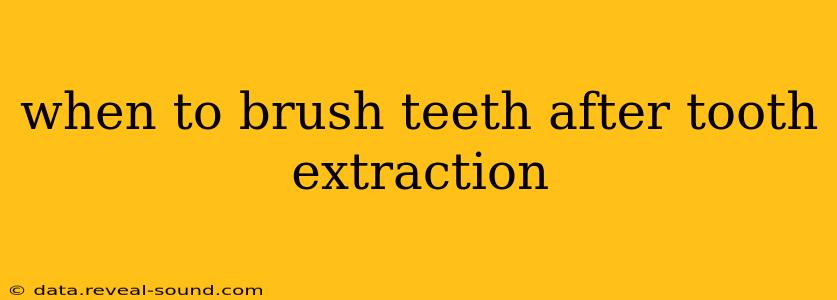Losing a tooth, whether through extraction or otherwise, can be a disruptive experience. Knowing how to care for your mouth during the healing process is crucial for preventing infection and ensuring a smooth recovery. One common question patients have is, "When can I brush my teeth after a tooth extraction?" This guide will provide a detailed answer, along with other important post-extraction care tips.
What Happens Immediately After a Tooth Extraction?
Following a tooth extraction, your dentist or oral surgeon will place gauze over the extraction site to control bleeding. They will also provide specific post-operative instructions. Initially, you'll need to maintain meticulous care to avoid disturbing the blood clot that forms in the socket. This blood clot is vital for healing and preventing a painful, potentially serious complication called dry socket.
How Long Should I Wait to Brush After Tooth Extraction?
The short answer is: wait at least 24 hours before brushing near the extraction site. This allows the blood clot to properly form and start the healing process. However, it's perfectly acceptable—and highly recommended—to brush the rest of your teeth as normal. Good oral hygiene is still essential, even when recovering from an extraction.
How Should I Brush After the 24-Hour Mark?
After the initial 24-hour waiting period, you can resume brushing your teeth, but with some modifications:
- Gentle Brushing: Use a soft-bristled toothbrush and be incredibly gentle around the extraction site. Avoid directly brushing the area for at least a week. Focus on the surrounding teeth and gums.
- Avoid Vigorous Scrubbing: Harsh brushing can dislodge the blood clot, leading to dry socket. Use soft, circular motions.
- Rinse Gently: After brushing, rinse your mouth gently with saltwater (1/2 teaspoon of salt in 8 ounces of warm water). Avoid forceful rinsing or spitting, as this can also disrupt the healing process.
- Monitor for Bleeding: Minimal bleeding is normal immediately after brushing, but if you experience excessive bleeding, contact your dentist.
What if I Develop a Dry Socket?
Dry socket (alveolar osteitis) occurs when the blood clot is lost from the extraction site, exposing the underlying bone and nerve endings. This is a very painful condition. Symptoms include intense pain, a bad taste in your mouth, and a visible empty socket. If you suspect you have a dry socket, contact your dentist or oral surgeon immediately. They can provide pain relief and dressings to promote healing.
Can I Use Mouthwash After Tooth Extraction?
It's generally recommended to avoid using mouthwash for at least 24 to 48 hours after a tooth extraction. Some mouthwashes contain alcohol, which can irritate the extraction site and impede healing. After that time, you can use a diluted, alcohol-free mouthwash. Always check with your dentist about the appropriate type of mouthwash to use and when you can start using it.
What About Flossing After Tooth Extraction?
Similar to brushing, avoid flossing near the extraction site for at least a week. This prevents dislodging the blood clot and disrupting healing. You can still floss the rest of your teeth, but be cautious and gentle.
When Can I Resume My Normal Oral Hygiene Routine?
You can usually resume your normal oral hygiene routine after about a week, but always follow your dentist's or oral surgeon's specific instructions. Regular brushing, flossing, and rinsing are essential for preventing infection and maintaining good oral health, even after a tooth extraction. Don't hesitate to ask your dentist or oral surgeon if you have any questions or concerns about caring for your mouth post-extraction. They are your best resource for personalized advice and ensuring a successful recovery.
